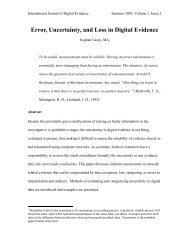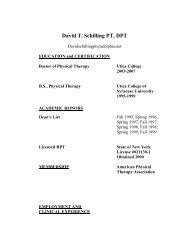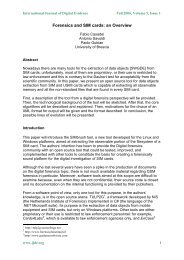Download PDF version - Utica College
Download PDF version - Utica College
Download PDF version - Utica College
You also want an ePaper? Increase the reach of your titles
YUMPU automatically turns print PDFs into web optimized ePapers that Google loves.
“The most frustrating part was during the construction<br />
(of the neighboring Romano Hall), because of the<br />
electrical supply to the room. The lights were going on<br />
and off. Because you want to limit your contact with<br />
the salamanders, we would only be in two days a week<br />
to water and feed. So you’d come in and everything<br />
would be off, and you’d be like, oh no, how long have<br />
the lights been off? Has it been two days, two hours?<br />
If it’s a one month experiment, the whole thing has to<br />
start over,” Alsheimer says, laughing.<br />
”TwENTY, THIRTY YEARS”<br />
These limitations notwithstanding, Wise says that<br />
the next stage of this research will be looking at digit<br />
regeneration – toes, to be exact – as well as developmental<br />
stages in salamanders and how each is affected<br />
by various light levels.<br />
She and Buchanan will also be working with Mc-<br />
Carthy on studying the behavior of aquatic snails.<br />
Because these snails live all over North America and<br />
can be raised from egg to adult in a small cup, Mc-<br />
Carthy says, they are very well adapted to the kinds of<br />
experiments being done at UC, which involve relatively<br />
confined spaces.<br />
“We can do all kinds of different things in terms of<br />
looking at their growth rates, how that differs between<br />
the different light exposures, when they mature, when<br />
they lay eggs, how many eggs they’re laying, what<br />
kinds of packets – really big egg packets with lots of<br />
eggs, or lots of little packets – all of those different<br />
variables,” he says.<br />
While McCarthy, a behavioral ecologist, is primarily<br />
interested in studying mating strategies and predatorprey<br />
interactions among invertebrates, a good deal of<br />
the light pollution work on snails has concentrated on<br />
development and reproduction. Results thus far have<br />
shown wide variations in estrogen and testosterone<br />
levels associated with different light levels as well as<br />
very different reproduction and growth rates.<br />
“Whether that’s tied to melatonin or not is an open<br />
question,” says McCarthy. “Are the hormones different<br />
because they’re reproducing differently, or are they reproducing<br />
differently because the hormones are different?<br />
So we need to figure out that aspect.” He shrugs,<br />
then adds dryly, “And that could take 20, 30 years.”<br />
Wise laughs at McCarthy’s grimly realistic comment.<br />
“That’s the whole thing,” she says. “You do one<br />
experiment like this and you get all these different<br />
questions that lead you into 20 years worth of work.<br />
That’s the way it goes.”<br />
Tradition. Opportunity. Transformation.®<br />
A COLLABORATIVE INSTITUTE<br />
Wise’s vision, shared by her colleagues, to move<br />
the research process forward is one of a light pollution<br />
institute housed at <strong>Utica</strong> <strong>College</strong>. “We have more<br />
people working on light pollution at this school than<br />
any other school,” she says. “In fact we probably have<br />
more people working on behavior than many, many<br />
other schools many times our size. We have a lot of<br />
behavioral ecologists here, so it makes for interesting<br />
collaborations.”<br />
One such collaboration being discussed is what Wise<br />
describes as a “cattle tank” study.<br />
“You take these cattle tanks and you can set up a<br />
mesocosm - a sort of mini pond,” she explains. “We<br />
would actually monitor these at different light levels,<br />
and that would involve Tom with the invertebrates<br />
and (Professor) Dave Moore to look at the algal and<br />
plankton growth. We would have a predator species,<br />
like a newt, and prey species like tadpoles or some<br />
invertebrates. Terri would look at the melatonin levels<br />
in these different organisms at the end of this experiment.<br />
So we could actually involve a huge number of<br />
faculty and of course students on top of that – a big,<br />
collaborative kind of project.”<br />
Whatever shape future research projects may take,<br />
faculty and students at UC will continue to contribute<br />
to the light pollution knowledge base in the<br />
years ahead. Their data are discussed at national and<br />
international conferences, published in major scientific<br />
journals, and have even found their way into popular<br />
publications such as Germany’s Der Spiegel.<br />
Greater public awareness of the dangers of light<br />
pollution can only be a good thing, according to<br />
Buchanan. From the standpoint of health, energy conservation,<br />
quality of life, and even crime prevention,<br />
night time lighting can result in significant waste and<br />
substantial harm.<br />
When asked what individuals can do to protect<br />
themselves, Buchanan shares a few simple steps.<br />
“Sleep with the lights off. Don’t let your kids sleep<br />
with night lights. If you have a green L.E.D. clock<br />
radio, go out and get a red one, or throw a sock or a<br />
towel over it. Don’t sleep with the TV on. If you’ve got<br />
a bright light outside, use dark shades,” he says.<br />
�<br />
MORE<br />
Learn more about light pollution at<br />
www.darksky.org<br />
pioneer 29 fall 2009










